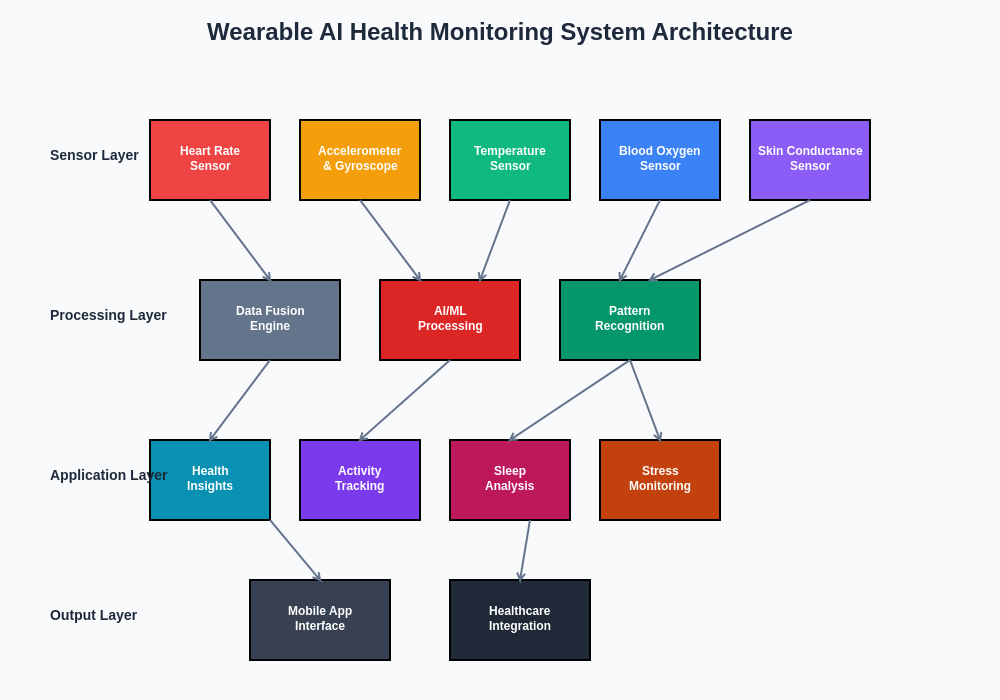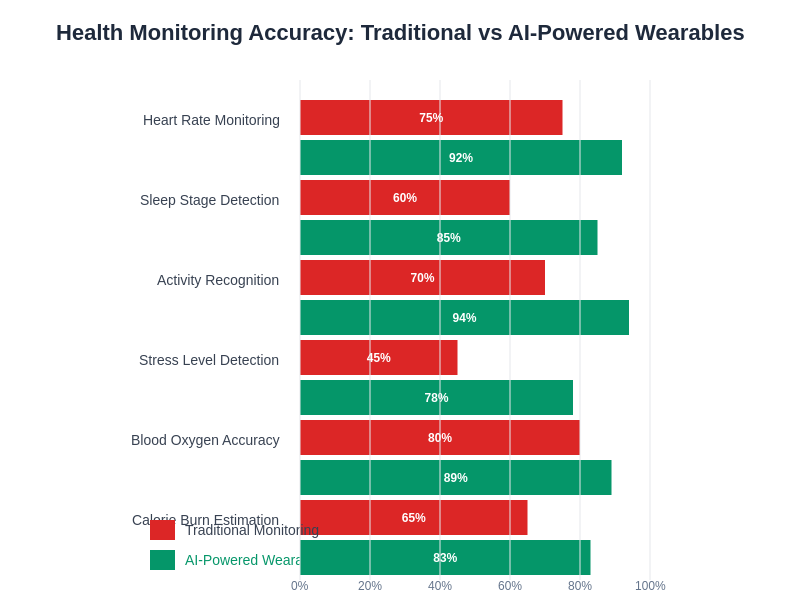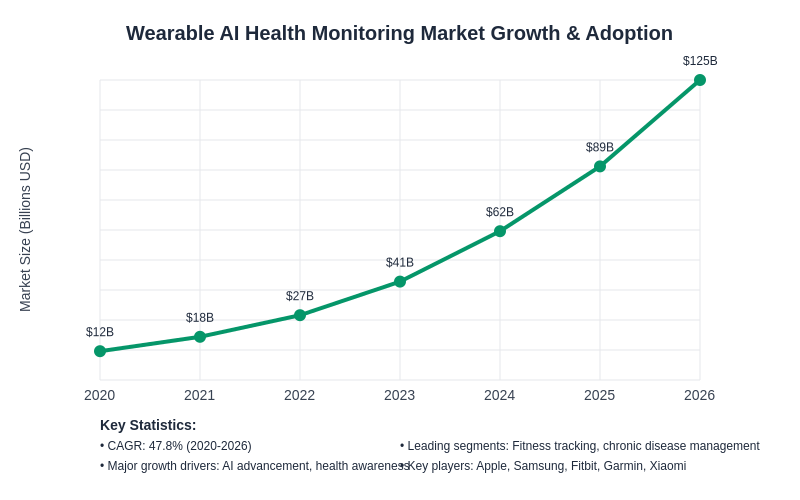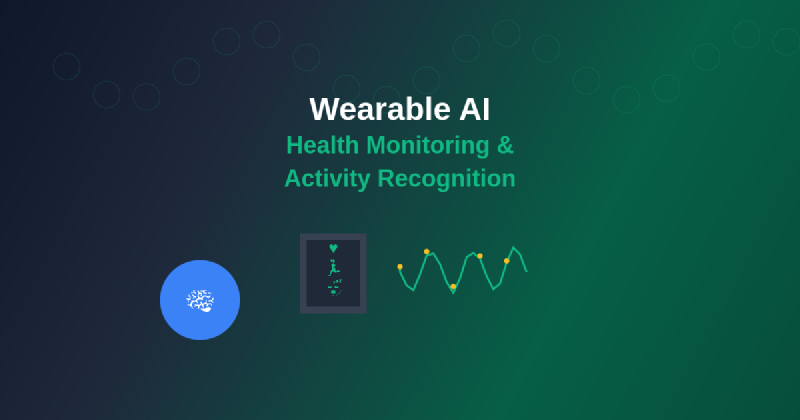The convergence of artificial intelligence and wearable technology has created an unprecedented revolution in personal healthcare monitoring, transforming how individuals track, understand, and optimize their health and fitness. This technological evolution represents far more than simple step counting or heart rate monitoring; it encompasses a sophisticated ecosystem of sensors, algorithms, and predictive analytics that continuously learns from user behavior to provide personalized health insights and early warning systems for potential medical conditions.
Explore the latest AI trends in healthcare to understand how wearable technology is becoming an integral part of modern healthcare delivery systems. The integration of artificial intelligence into wearable devices has created possibilities that were once confined to the realm of science fiction, enabling real-time health monitoring, predictive health analytics, and personalized wellness recommendations that adapt to individual user patterns and preferences.
The Evolution of Intelligent Wearable Technology
The journey from basic pedometers to sophisticated AI-powered health monitoring devices represents one of the most significant technological progressions in consumer electronics history. Modern wearable devices incorporate multiple advanced sensors including accelerometers, gyroscopes, heart rate monitors, blood oxygen sensors, electrocardiogram capabilities, skin temperature sensors, and even stress detection mechanisms. These sensors work in concert with powerful artificial intelligence algorithms to create comprehensive health profiles that provide users with actionable insights into their physical and mental well-being.
The transformation has been particularly remarkable in the realm of data processing and interpretation. While early wearable devices could only collect basic metrics, today’s AI-powered wearables can analyze complex patterns in biometric data, identify anomalies that might indicate health issues, and provide predictive insights that help users make informed decisions about their lifestyle choices. This evolution has fundamentally changed the relationship between individuals and their health data, moving from passive data collection to active health management and optimization.
Advanced Sensor Integration and Data Fusion
The sophistication of modern wearable AI lies in its ability to seamlessly integrate data from multiple sensors to create a comprehensive understanding of user health and activity patterns. Advanced machine learning algorithms analyze data streams from accelerometers that detect movement patterns, photoplethysmography sensors that monitor heart rate variability, galvanic skin response sensors that measure stress levels, and environmental sensors that track ambient conditions affecting health and performance.
This multi-sensor approach enables wearable devices to distinguish between different types of activities with remarkable accuracy, recognizing the difference between running and cycling, detecting sleep stages including REM and deep sleep phases, identifying stress patterns throughout the day, and even predicting potential health events based on subtle changes in biometric patterns. The fusion of this diverse sensor data through sophisticated AI algorithms creates a holistic view of user health that was previously impossible to achieve through any single monitoring method.
Experience advanced AI capabilities with Claude to understand how machine learning algorithms process complex health data and generate meaningful insights for preventive healthcare applications. The computational complexity involved in real-time health monitoring requires sophisticated artificial intelligence systems capable of processing vast amounts of sensor data while maintaining user privacy and delivering actionable recommendations.
Revolutionary Activity Recognition Capabilities
Activity recognition represents one of the most impressive achievements in wearable AI technology, moving far beyond simple step counting to provide detailed analysis of complex movement patterns and exercise routines. Modern AI algorithms can automatically detect and classify dozens of different activities including walking, running, cycling, swimming, weightlifting, yoga, dancing, and even specific sports movements with remarkable precision and minimal user intervention.
The machine learning models powering these recognition systems have been trained on massive datasets containing movement patterns from thousands of users across diverse demographics and fitness levels. This extensive training enables the algorithms to adapt to individual movement patterns while maintaining accuracy across different user groups. The technology can distinguish between similar activities such as different swimming strokes, various types of strength training exercises, and even subtle differences in walking patterns that might indicate changes in health status or mobility.
The practical applications of advanced activity recognition extend well beyond fitness tracking. Healthcare providers can use this technology to monitor patient recovery progress, physical therapists can track rehabilitation exercises, and researchers can gather unprecedented insights into human movement patterns and their relationship to health outcomes. The ability to automatically log and analyze physical activity eliminates the burden of manual tracking while providing comprehensive data for health optimization and medical assessment.
Intelligent Health Monitoring and Early Detection
Perhaps the most transformative aspect of wearable AI lies in its potential for early detection of health issues and continuous monitoring of chronic conditions. Advanced algorithms analyze patterns in heart rate variability, sleep quality, activity levels, and other biometric markers to identify subtle changes that might indicate the onset of medical conditions or the need for lifestyle modifications. This proactive approach to health monitoring represents a fundamental shift from reactive healthcare to preventive wellness management.
The technology has shown particular promise in detecting irregular heart rhythms, sleep disorders, respiratory issues, and stress-related conditions. Some advanced wearable devices can even monitor blood glucose levels, detect falls in elderly users, and provide early warnings for potential cardiac events. The continuous nature of this monitoring provides healthcare providers with longitudinal health data that was previously impossible to obtain outside of clinical settings.
The integration of AI-powered health monitoring into everyday life has democratized access to sophisticated health tracking capabilities that were once available only in medical facilities. Users can now receive personalized health insights, track the effectiveness of treatments or lifestyle changes, and maintain detailed health records that can be shared with healthcare providers for more informed medical decisions.
Personalized Health Insights and Recommendations
The true power of wearable AI emerges through its ability to learn from individual user patterns and provide personalized recommendations that adapt to unique lifestyle requirements and health goals. Machine learning algorithms analyze historical data, identify patterns in user behavior, and generate customized suggestions for optimizing sleep, exercise, nutrition, and stress management based on individual responses and preferences.
These personalized insights go far beyond generic health advice, taking into account factors such as work schedules, exercise preferences, sleep patterns, stress triggers, and physiological responses to different activities. The AI can recommend optimal workout times based on energy levels, suggest stress management techniques during high-pressure periods, and even provide personalized sleep optimization strategies based on individual sleep architecture and lifestyle factors.
The continuous learning aspect of these systems means that recommendations become more accurate and relevant over time as the AI develops a deeper understanding of individual user patterns and responses. This personalization extends to goal setting, where the AI can suggest realistic targets based on current fitness levels and progress patterns, helping users achieve sustainable improvements in their health and fitness.

The complex architecture underlying modern wearable AI systems demonstrates the sophisticated integration of sensors, processing units, and communication systems required to deliver real-time health monitoring and intelligent recommendations to users while maintaining privacy and security standards.
Sleep Analysis and Optimization
Sleep monitoring represents one of the most sophisticated applications of wearable AI technology, utilizing multiple sensors and advanced algorithms to provide detailed analysis of sleep quality, duration, and architecture. Modern devices can track sleep stages including light sleep, deep sleep, and REM phases, monitor sleep efficiency, detect sleep disturbances, and identify patterns that affect sleep quality such as stress levels, exercise timing, and environmental factors.
The AI algorithms powering sleep analysis have been trained on extensive polysomnography data and validated against clinical sleep studies to ensure accuracy in sleep stage detection and quality assessment. This technology provides users with actionable insights into their sleep patterns, including recommendations for improving sleep hygiene, optimizing bedtime routines, and identifying lifestyle factors that impact sleep quality.
Enhance your research capabilities with Perplexity to explore the latest developments in sleep science and understand how AI-powered sleep monitoring is contributing to our understanding of sleep’s role in overall health and cognitive performance. The comprehensive sleep data collected by wearable devices is providing researchers with unprecedented insights into population sleep patterns and their relationship to various health outcomes.
Stress Detection and Mental Health Monitoring
The integration of stress detection capabilities into wearable AI systems represents a significant advancement in mental health monitoring and management. Advanced algorithms analyze heart rate variability, skin conductance, movement patterns, and other physiological markers to detect stress levels throughout the day and provide real-time feedback and intervention suggestions to help users manage stress more effectively.
The technology can identify stress triggers, track the effectiveness of stress management techniques, and provide personalized recommendations for stress reduction based on individual response patterns. Some advanced systems can even detect early signs of anxiety or depression through changes in activity patterns, sleep quality, and physiological markers, potentially providing early intervention opportunities for mental health issues.
The continuous monitoring of stress and mental health indicators through wearable AI represents a paradigm shift in mental health care, moving from episodic clinical assessments to continuous monitoring and intervention. This approach enables more proactive mental health management and provides healthcare providers with detailed data about patient stress patterns and responses to treatments.
Chronic Disease Management and Clinical Integration
Wearable AI technology has shown tremendous promise in supporting the management of chronic diseases such as diabetes, hypertension, heart disease, and respiratory conditions. Continuous monitoring capabilities enable patients and healthcare providers to track disease progression, monitor treatment effectiveness, and identify patterns that might indicate the need for treatment adjustments or medical intervention.
For diabetes management, advanced wearable devices can monitor blood glucose levels continuously and provide alerts for dangerous fluctuations, while AI algorithms learn individual patterns and predict potential hypoglycemic or hyperglycemic episodes. Heart disease patients benefit from continuous cardiac rhythm monitoring and early detection of irregular heartbeats that might require medical attention.
The integration of wearable AI data into clinical workflows is transforming how healthcare providers monitor and treat chronic conditions. Real-world health data collected through wearable devices provides a more comprehensive picture of patient health than traditional clinical visits, enabling more personalized treatment plans and better outcomes for patients with chronic conditions.

The accuracy improvements achieved through AI-powered wearable devices compared to traditional monitoring methods demonstrate the significant advancement in consumer health technology and its potential for clinical applications in various healthcare settings.
Privacy, Security, and Data Protection
The collection and processing of sensitive health data through wearable AI systems raises important questions about privacy, security, and data protection that must be addressed to maintain user trust and ensure responsible deployment of these technologies. Advanced encryption methods, secure data transmission protocols, and privacy-preserving machine learning techniques are essential components of modern wearable AI systems.
Many leading wearable device manufacturers have implemented comprehensive privacy frameworks that include on-device processing to minimize data transmission, user control over data sharing, transparent privacy policies, and compliance with healthcare data protection regulations such as HIPAA. The development of federated learning approaches enables AI model improvement without compromising individual user privacy by training algorithms on distributed data without centralizing sensitive health information.
The balance between providing personalized health insights and protecting user privacy requires ongoing attention and innovation in privacy-preserving technologies. Users must be educated about data collection practices and given meaningful control over how their health data is used and shared, while developers must continue to improve security measures and privacy protection mechanisms.
Future Innovations and Emerging Technologies
The future of wearable AI in health monitoring promises even more sophisticated capabilities through advances in sensor technology, artificial intelligence algorithms, and integration with other health technologies. Emerging developments include non-invasive blood glucose monitoring, continuous blood pressure measurement, hydration level detection, and even early detection of infectious diseases through changes in physiological patterns.
Advances in artificial intelligence are enabling more sophisticated predictive analytics that can forecast health events days or weeks in advance, providing unprecedented opportunities for preventive intervention. Integration with smart home systems, electronic health records, and telemedicine platforms is creating comprehensive health ecosystems that support continuous care and monitoring.
The development of more advanced materials and miniaturized sensors is enabling the creation of increasingly unobtrusive wearable devices that can monitor health parameters without interfering with daily activities. Future innovations may include smart clothing with integrated sensors, implantable monitoring devices, and even temporary tattoo-like sensors that provide continuous health monitoring for specific medical conditions.
Impact on Healthcare Delivery and Population Health
The widespread adoption of wearable AI technology is beginning to transform healthcare delivery systems and population health management approaches. The availability of continuous health data from large populations provides public health researchers with unprecedented insights into disease patterns, health trends, and the effectiveness of health interventions at a population level.
Healthcare systems are exploring ways to integrate wearable device data into clinical decision-making processes, enabling more personalized treatment plans and improved patient outcomes. Remote patient monitoring through wearable devices has become particularly valuable for managing chronic conditions and providing care to patients in rural or underserved areas where access to healthcare facilities may be limited.
The democratization of health monitoring through affordable wearable AI devices has the potential to reduce healthcare disparities by providing individuals with tools to monitor and manage their health regardless of their access to traditional healthcare services. This technology empowers individuals to take a more active role in their health management while providing healthcare providers with valuable data for improving care delivery.

The rapid growth in wearable AI adoption and market expansion reflects the increasing recognition of these technologies’ value in personal health management and their potential for transforming healthcare delivery systems worldwide.
Challenges and Limitations
Despite the remarkable advances in wearable AI technology, several challenges and limitations remain that must be addressed for the technology to reach its full potential. Accuracy limitations in certain measurements, particularly for medical-grade applications, require ongoing research and development to improve sensor precision and algorithm reliability.
Battery life constraints continue to limit the functionality and convenience of wearable devices, particularly those with advanced AI processing capabilities and multiple sensors. The trade-off between device capabilities and battery life requires careful optimization and continued advances in low-power computing and energy-efficient AI algorithms.
User compliance and long-term engagement represent significant challenges for wearable AI systems, as the value of these devices depends on consistent use and data collection. Designing engaging user experiences that encourage long-term adoption while providing meaningful value to users requires ongoing attention to user interface design and motivation strategies.
Regulatory Considerations and Clinical Validation
The increasing integration of wearable AI devices into healthcare applications raises important questions about regulatory oversight and clinical validation of these technologies. As wearable devices begin to provide medical-grade measurements and health recommendations, regulatory agencies are developing frameworks for evaluating and approving these technologies for clinical use.
Clinical validation studies are essential for establishing the accuracy and reliability of wearable AI systems for medical applications. These studies must demonstrate that wearable device measurements are sufficiently accurate for clinical decision-making and that AI algorithms provide reliable and beneficial health insights for users.
The development of industry standards for wearable health monitoring devices is crucial for ensuring interoperability, data quality, and user safety. Collaboration between device manufacturers, healthcare providers, and regulatory agencies is essential for establishing appropriate oversight frameworks that promote innovation while protecting user safety and privacy.
Conclusion and Future Outlook
Wearable AI technology represents a transformative force in personal health monitoring and healthcare delivery, providing individuals with unprecedented access to sophisticated health tracking capabilities while enabling new approaches to disease prevention, management, and treatment. The integration of artificial intelligence into wearable devices has created possibilities for continuous health monitoring, predictive analytics, and personalized health optimization that were previously impossible outside of clinical settings.
The continued advancement of sensor technology, artificial intelligence algorithms, and integration capabilities promises to unlock even greater potential for wearable AI in health monitoring and activity recognition. As these technologies mature and become more accessible, they have the potential to democratize access to advanced health monitoring capabilities and transform how individuals and healthcare systems approach health and wellness.
The success of wearable AI in health monitoring will ultimately depend on continued innovation in technology development, thoughtful attention to privacy and security concerns, appropriate regulatory oversight, and meaningful integration into healthcare delivery systems. The future of personal health monitoring lies in the intelligent collaboration between human users, AI algorithms, and healthcare providers to create more proactive, personalized, and effective approaches to health and wellness management.
Disclaimer
This article is for informational purposes only and does not constitute medical advice. The information presented about wearable AI technology and health monitoring should not be used as a substitute for professional medical consultation, diagnosis, or treatment. Readers should consult with qualified healthcare providers before making health-related decisions based on wearable device data. The accuracy and reliability of wearable health monitoring devices may vary, and these devices should not be relied upon for medical emergencies or critical health decisions.
